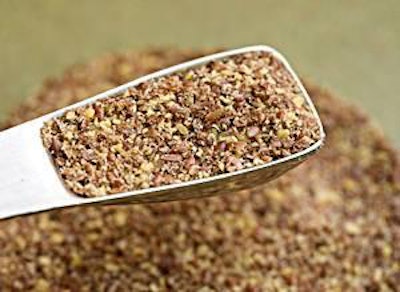
Producing omega-3 enriched eggs is a rapidly expanding niche market. This is because consumers have realized that the health benefits from a diet rich in omega-3 fatty acids outweigh the slight increase in price they are asked to pay for these eggs.
It is highly anticipated that this trend will increase, offering not only an excellent way for consumers to safeguard their health, but also, a new outlet for egg producers to improve their competitiveness and image in the health food sector.
To increase the concentration of omega-3 fatty acids in eggs, it is imperative to provide layers with a diet enriched in the same fatty acids. Like all monogastrics, birds deposit lipids in their body, and consequently in eggs, without changing the form from that ingested through feed.
To this effect, a diet rich in omega-3 fatty acids is the only way to produce such eggs. And, to enrich the layer’s feed with omega-3 fatty acids there is only a very limited range of ingredients with a suitable profile and price: fish meal and fish oil, rapeseed and rapeseed oil, and flax seed and flax oil.
Feeding high levels of fish meal or oil, such as those required to enrich eggs with omega-3 fatty acids is impractical because of ensuing low feed acceptability, risk of ‘fishy’ smell in eggs, low sustainability of fish meal and oil production, and of course, the high price for fish meal and oil.
Rapeseed meal and oil is indeed a much better choice, but the levels required again are too high due to their intermediate concentration of omega-3 fatty acids. Again, with this ingredient, a ‘fishy’ smell is produced in hens carrying the ‘Rhode Island’ gene, which is not present only in ‘brown’ layers. A more suitable ingredient is flaxseed, or flax.
Flaxseed
Flax is grown mainly in areas with a cold climate, such as Canada and northern Europe. The main reason for cultivation is the oil (flaxseed contains 34% total lipids), but some linen varieties are still cultivated in Europe. Flaxseed meal, as a co-product of oil extraction, has limited value (and high fiber content) for feeding to layers. Only full-fat flaxseed is suitable for the purpose of producing omega-3 enriched eggs.
Flaxseed is an excellent source of omega-3 fatty acids: alpha-linolenic acid (the primary omega-3 fatty acid) makes up about 57% of total fatty acids in flaxseed, with linoleic acid, an omega-6 fatty acid, comprising only 16% of total fatty acids. In general, flaxseed contains about 9% saturated fatty acids, 18% monounsaturated fatty acids, and 73% polyunsaturated fatty acids.
From a nutritional point of view, flaxseed contains about 22% crude protein (which increases the requirement for crystalline amino acids when replacing soybean meal), 6% crude fiber, and 15-18 MJ/kg metabolizable energy (depending on thermal processing of feed and flaxseed). Incorporating flaxseed in conventional layer diets does not present major issues from a formulation standpoint, once the above are taken into account.
Inclusion rate
In most markets, enriched eggs are required to contain about 300 mg omega-3 fatty acids. To begin with, a normal egg, produced on a diet based on cereals and soybean meal, contains about 50 mg omega-3 fatty acids. If we accept the rule of thumb proposed by Drs. Leeson and Summers (University of Guelph) in that, 1% inclusion rate of flaxseed results in an increase of 40 mg omega-3 fatty acids in the egg, then we need to add about 6% to reach a minimum of 300 mg in the egg. But, to account for biological variability, both in flax and hens, it is recommended to feed a minimum of 8% and a maximum of 10%.
Issues with flaxseed
Flaxseed contains a considerable range of anti-nutritional factors at significant concentrations, not unlike soybeans.
These factors include: mucilage, trypsin inhibitor, phytic acid, cyanogenic glucosides, and potentially rancid lipids. All these compounds reduce feed acceptance and digestibility of nutrients.
To counter the effects of anti-nutritional factors, heat treatment of seeds and/or whole diets has been shown to vastly improve digestibility and feed acceptance, again not unlike the case with soybeans. Nevertheless, flaxseed should be introduced gradually into diets for young layers, in weakly increments of 2% (or more if flaxseed or the whole diet is heat treated).
Although whole (unground) flaxseed has been used with success, it is generally recommended to grind it before feeding to layers. In a controlled study, grinding increased deposition of alpha-linolenic acid from 13.5 to 16.2 mg/g of yolk. It is, of course, common knowledge that grinding improves nutrient digestibility, but the small size and tough nature of flax make the feeding of unground seeds a tempting option, especially for small operations. To this end, feeding 0.5% grid has been shown to improve digestibility of unground seeds and deposition of omega-3 fatty acids in eggs.
Issues with egg production
In some earlier studies, egg production had been reduced when feeding flaxseed. Other observations related to feeding flaxseed included lower egg weight, lower body weight of hens, and reduced egg shell strength. It is now understood that the energy content of flaxseed had been overestimated and the effects of anti-nutritional factors underestimated. Thus, thermal processing, grinding, enzyme supplementation, use of correct metabolizable energy values, and proper balancing of all nutrients are all required to ensure comparable performance in hens fed flaxseed. Indeed, there have been reports where feeding flaxseed actually improved egg production!
Finally, it should be noted that flaxseed has a natural laxative effect; although this should not be of a major concern at levels below 10% in the diet. In addition, the high mucilage concentration creates ‘sticky’ droppings that reduce the quality of living conditions in hens, and also increase the number of ‘dirty’ eggs. The use of a beta-glucanase enzyme has been shown to help towards solving this problem, when and if it happens.
After taking into account the natural biological characteristics of flaxseed, and conforming to new findings on how to properly use this ingredient, it is now possible to depend solely on flaxseed to produce eggs enriched in omega-3 fatty acids.















